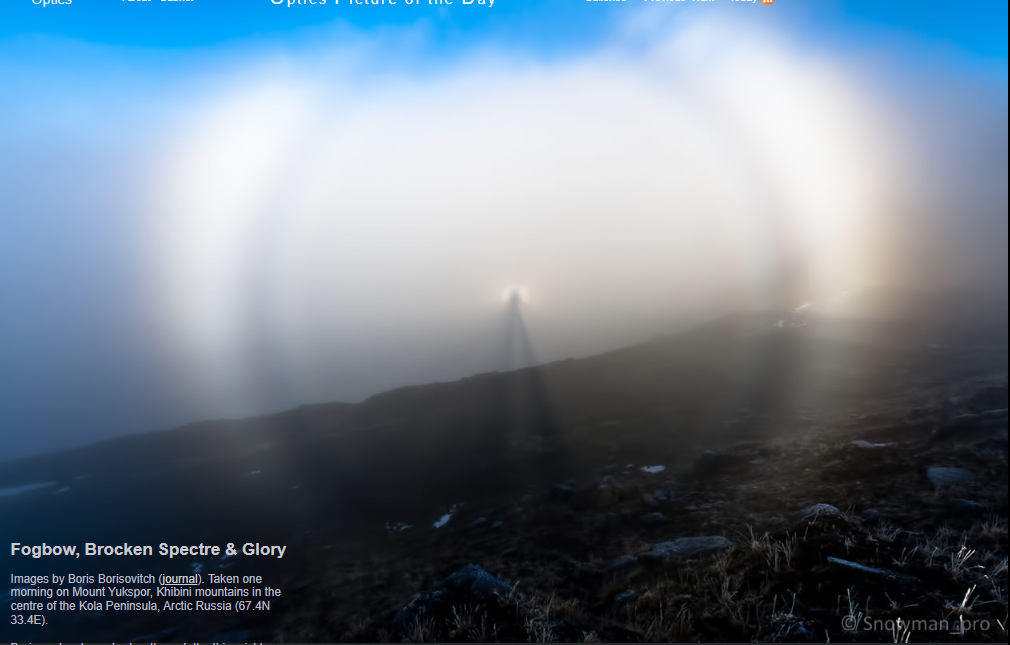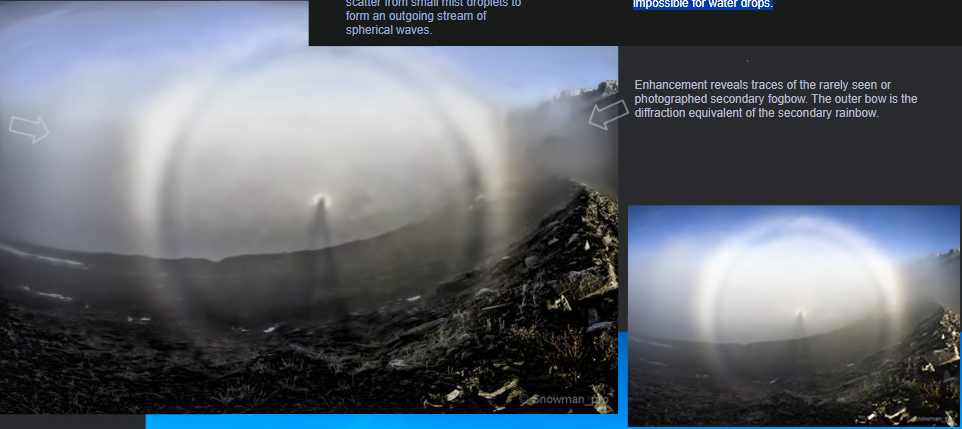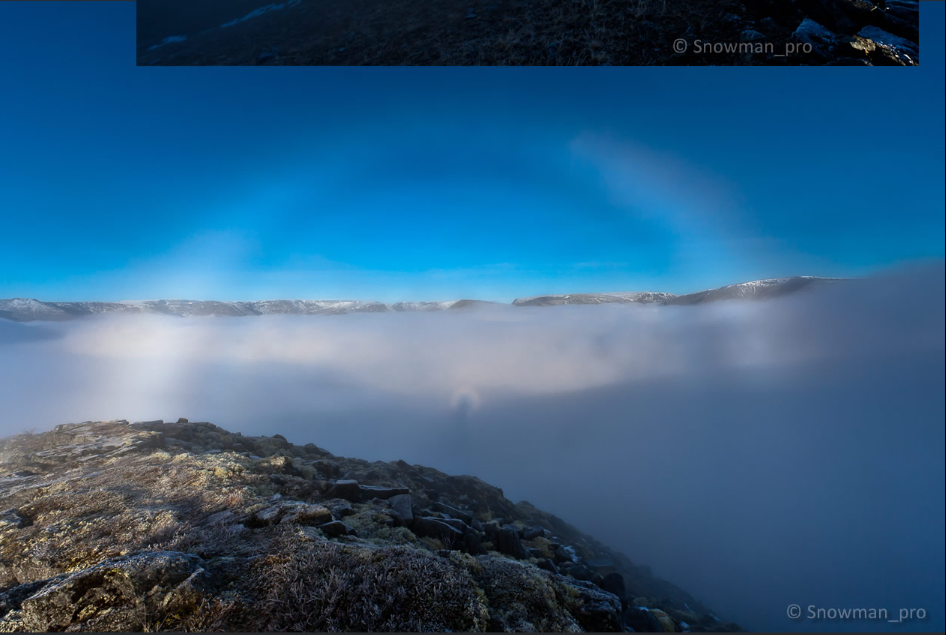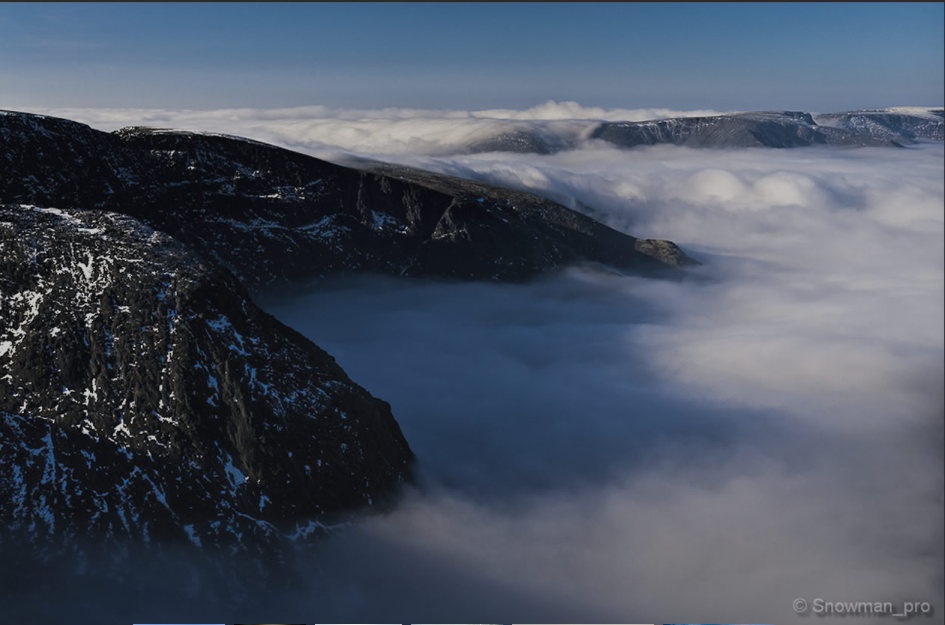Fogbow, Brocken 7 Glory, Russia - OPOD
The Enigmatic Phenomenon of Fogbow, Brocken Spectre, and Glory
Have you ever witnessed a surreal atmospheric phenomenon that left you in awe? One such mesmerizing sight is the combination of a fogbow, Brocken spectre, and glory, as captured by Boris Borisovitch on a misty morning atop Mount Yukspor in the Khibini mountains of Arctic Russia. Let's delve into the intricacies of these ethereal phenomena and explore the science behind their formation.
The Brocken Spectre and the Ghostly Shadow
As Boris casts his gaze into the thin mist, his figure creates a hauntingly beautiful phenomenon known as the Brocken spectre. This optical illusion occurs when sunlight is cast upon a cloud or fog from behind, causing the shadow of an observer to be projected onto the mist. The magnification and distortion of the shadow give it an otherworldly appearance, often surrounded by a halo-like glow.
The Mysterious Circular Glory
Within the Brocken spectre's shadow lies a captivating circular glory. Unlike the well-understood rainbow phenomenon, the glory lacks a classical ray path analogue. Its formation is enigmatic and seemingly defies the principles observed in water droplets. The size of the glory is highly sensitive to the size of the mist droplets, which can cause it to vary in appearance during its apparition.
The Intricate Fogbow
Dominating the scene is a massive fogbow, an ethereal cousin of the rainbow. While rainbows are formed by the refraction and reflection of sunlight through raindrops, fogbows owe their existence to the scattering of sunlight by tiny mist droplets. The smaller size of these droplets results in diffraction, causing the fogbow to appear as a diffuse, almost colorless ring instead of a vividly colored arc.
Supernumerary Fringes: Adding a Splash of Color
Within the fogbow, a striking inner fringe of colors can be observed. These supernumerary fringes occur due to the interference of light waves as they pass through the mist droplets. The interaction between the incoming and outgoing waves creates additional bands of colors, adding a touch of vibrancy to the fogbow's otherwise pale appearance.
Unveiling the Secondary Fogbow
Upon closer inspection, traces of a secondary fogbow can be discerned. This rarely seen or photographed phenomenon is the diffraction equivalent of the secondary rainbow. The secondary fogbow appears as a fainter outer ring surrounding the primary fogbow, further enhancing the ethereal beauty of the scene.
The Dance of Sunlight and Mist Droplets
To understand the formation of these atmospheric marvels, we must explore the interplay between sunlight and mist droplets. Incoming plane waves of sunlight scatter from the tiny droplets, creating a stream of spherical waves that illuminates the surrounding mist. When these waves are internally reflected once within the droplets, they give rise to the fogbow phenomenon.
The Science Behind the Glory
While the exact mechanism behind the glory remains elusive, scientists believe that it involves intricate processes within the mist droplets. The interplay of diffraction, interference, and scattering of light waves within the droplets contributes to the glory's mesmerizing appearance. The size and distribution of the droplets play a crucial role in determining the size and intensity of the glory.
The Beauty of Atmospheric Optics
The combination of a fogbow, Brocken spectre, and glory is a testament to the captivating beauty of atmospheric optics. These rare and ephemeral phenomena remind us of the intricate interplay between light and matter in our atmosphere. Each sighting offers a unique glimpse into the wonders of nature, leaving us in awe of the hidden intricacies that surround us.
Conclusion
Witnessing the ethereal dance of a fogbow, Brocken spectre, and glory is a truly awe-inspiring experience. These atmospheric optics phenomena serve as a reminder of the complex interplay between sunlight, mist droplets, and our perception of light. As we continue to explore the mysteries of the natural world, let us cherish these fleeting moments of enchantment and marvel at the wonders that surround us.

Fogbow, Brocken Spectre & Glory
Images by Boris Borisovitch (journal). Taken one morning on Mount Yukspor, Khibini mountains in the centre of the Kola Peninsula, Arctic Russia (67.4N 33.4E).
Boris casts a long shadow through the thin mist to create a ghostly ‘Brocken Spectre’.
Surrounding his head’s shadow, or more accurately the position the camera shadow would occupy, is a small bright circular glory.
The whole scene is dominated by a huge and almost white fogbow with an inner, more coloured, supernumerary fringe.
An account of the morning with many more images is here.
All images ©Boris Borisovitch, Snowman.pro and shown with permission

Incoming plane waves of sunlight scatter from small mist droplets to form an outgoing stream of spherical waves.

Waves internally reflected once make the fogbow. Wave spread, diffraction, gives a diffuse almost colourless ring rather than the sharp highly coloured rainbow produced by much larger raindrops.
The central glory is more mysterious. It has no classical ray path analogue - That shown is impossible for water drops.

Enhancement reveals traces of the rarely seen or photographed secondary fogbow. The outer bow is the diffraction equivalent of the secondary rainbow.

The glory is rather more sensitive to droplet size than the fogbow. Its size changed during the apparition.


Note: this article has been automatically converted from the old site and may not appear as intended. You can find the original article here.
Reference Atmospheric Optics
If you use any of the definitions, information, or data presented on Atmospheric Optics, please copy the link or reference below to properly credit us as the reference source. Thank you!
-
<a href="https://atoptics.co.uk/blog/fogbow-brocken-7-glory-russia-opod/">Fogbow, Brocken 7 Glory, Russia - OPOD</a>
-
"Fogbow, Brocken 7 Glory, Russia - OPOD". Atmospheric Optics. Accessed on November 26, 2024. https://atoptics.co.uk/blog/fogbow-brocken-7-glory-russia-opod/.
-
"Fogbow, Brocken 7 Glory, Russia - OPOD". Atmospheric Optics, https://atoptics.co.uk/blog/fogbow-brocken-7-glory-russia-opod/. Accessed 26 November, 2024
-
Fogbow, Brocken 7 Glory, Russia - OPOD. Atmospheric Optics. Retrieved from https://atoptics.co.uk/blog/fogbow-brocken-7-glory-russia-opod/.